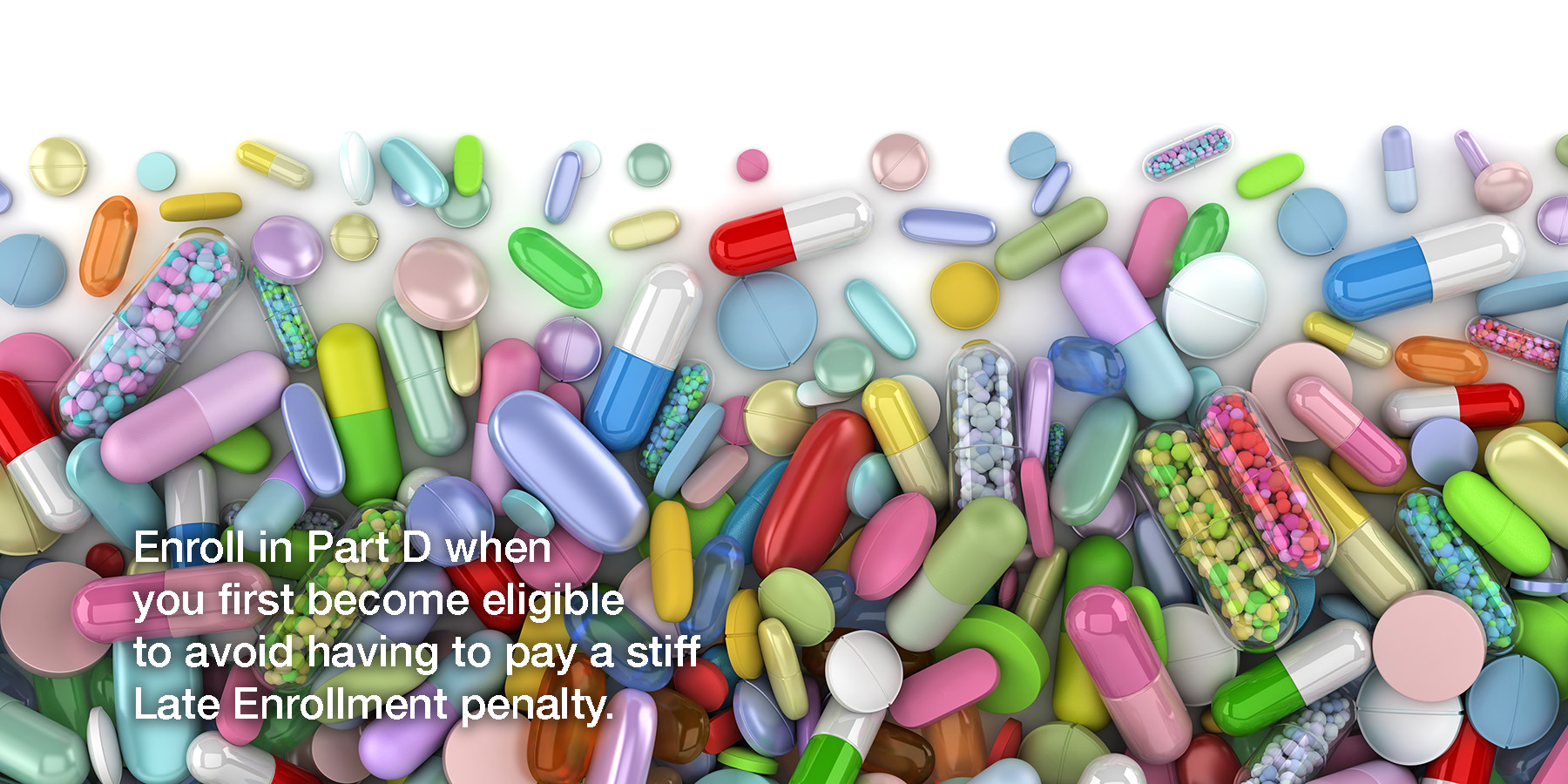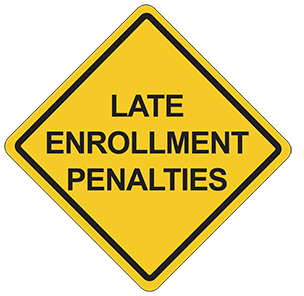Part D Prescription Drug Plan
Part D is an optional prescription drug program for people on Medicare. In order to receive this coverage you need to either join a standalone Part D Prescription Drug insurance plan or be enrolled in a Medicare Advantage plan or other Medicare health plan that includes prescription drug coverage. In both instances you will need to be eligible for Medicare Part A and enrolled in Part B before joining these plans.
How does it work?
These plans are administered by insurance carriers following federal guidelines. You will pay a monthly premium for your plan, which varies with each plan provider. When you use the plan’s network of pharmacies, instead of paying full price, you will pay a copay or percentage of cost.
To better understand Medicare Part D, let’s look at how each Part D plan works. There are 3 stages to a Part D drug plan, as follows:
1. Annual Deductible
In 2025, the allowable Medicare Part D deductible is $590. Plans may charge the full Part D deductible, a partial deductible, or waive the deductible entirely. You will pay the network discounted price for your medications until you have satisfied the deductible. After that, you enter the initial coverage stage.
2. Initial Coverage
During this stage of Part D drug coverage, you will pay a copay or coinsurance for your medications based on your plan’s drug formulary. The formulary separates its medications into tiers 1–5.* Each tier has a copay amount. Some plans waive the deductible for Tier 1 and 2 drugs. A copay is a set rate you pay for prescriptions, doctor visits, or other type of care. Coinsurance is the percentage of costs you pay after you’ve met your deductible. In 2025, that amount is twenty-five percent. During this phase, the sponsor (insurance company) typically pays 65% of the cost of applicable drugs and 75% of the cost of all other Part D drugs; manufacturers will typically pay a 10% discount for brand-name drugs and biologics.
- Tier 1 consists of commonly prescribed generic drugs, and is the lowest priced.
- Tier 2 drugs are generic and slightly more costly than Tier 1 drugs.
- Tier 3 medications are brand name prescription drugs without a generic equivalent. They can also include higher-priced generics as well as specialty medications.
- Tier 4 drugs are brand-name, specialty, or higher-priced generics that do not have a less expensive equivalent . They are typically more expensive than those in Tier 3.
- Tier 5 consists of high-cost specialty drugs that treat complex conditions. They may be brand-name, specialty or generic medications. They are typically the highest priced medications.
Once your total out-of-pocket costs reach a total of $2,000 (after fulfilling the deductible), you are through Initial Coverage and enter the Catastrophic Coverage phase. The out-of-pocket costs that count toward reaching the Catasrophic phase are known as “true out-of-pocket” costs (TrOOP); some amounts paid by a third party may count toward TrOOP.
* Some companies use a 4-tier system, some use a 6-tier system. The majority use a 5-tier system. Various pieces of legislation have capped cost-sharing insulin products, effectively creating yet another tier.
3. Catastrophic Coverage
After you’ve reached the end of the initial coverage phase, you pay nothing. All medications covered on the formulary from this point forward will be covered at 100%. The manufacturer pays 20% and the plan pays 80% of the drugs’ costs of your formulary medications for the rest of the year.
4. Plan Year Restarts
Everything resets on January 1, and you return to the deductible stage at the beginning of the next year.
What you pay for Part D
Premium
Standalone Part D plans charge a premium and each plan sets the amount it charges. Medicare Advantage plans with drug coverage generally charge one premium for all benefits — medical, hospital and prescription drugs.
Deductible
Some plans charge a deductible and others do not. Plans may also have a deductible for some drugs and not for others. Deductible amounts could also vary from one drug tier to another.
Medicare sets a maximum deductible amount each year. The maximum annual deductible a Part D plan may charge in 2025 is $590.
Copay
A copay is a fixed amount a beneficiary pays for covered medication; it is generally required each time you fill a prescription. Copay amounts may vary based on a plan’s formulary tiers — the lower the tier, the lower your cost. Copay amounts may also vary depending on which pharmacy you use.
Each plan sets its own copay terms and amounts, and these can vary widely from plan to plan.
Coinsurance
This is the percentage of costs for which a beneficiary is responsible after having paid the deductible. In 2025 plans may set coinsurance rates for certain drugs or drug tiers. The maximum coinsurance rate is 25 percent.
| Stages of Drug Coverage | You Pay | Manufacturer's Discount | Plan Pays | Medicare Pays | |
|---|---|---|---|---|---|
| 1 | Annual Deductible |
$590 | Plan may waive all or part of deductible | ||
| 2 | Initial Coverage |
25% | 10% | 65% | |
| 3 | Catastrophic Coverage* |
0% | 20% | 60% | 20% |
| * Once you enter Catastrophic Coverage you pay nothing for your covered Part D drugs for the rest of the calendar year. | |||||
Choosing a plan
It pays to review your Part D coverage every year, especially if you have started taking new drugs. The drugs you take may have moved to a different tier. Your premium, copay and deductible may change. Paying attention to your drug plan can help you save significantly year-to-year.
Getting financial help
Individuals who meet income and asset requirements may qualify for Extra Help from Medicare to pay their Part D premiums and out-of-pocket drug costs.
| You May Qualify if Your: | Annual Income Is Less Than | Total Assets*Are Less Than | |||
|---|---|---|---|---|---|
| Individuals | $22,835 | $17,220 | |||
| Couples | $30,900 | $34,360 | |||
| * Many assets are excluded, including your primary residence, personal property and household belongings, one motor vehicle, burial expense (up to $1,500), Life insurance (up to $1,500), certain trusts, other income. | |||||
About Part D Drugs
Part D and MAPD plans generally do not include all drugs available in each category of covered drugs because in some cases, several similar drugs are available to treat the same medical condition. The drugs a plan covers are on a list known as a “formulary,” developed by doctors, pharmacists, and other experts.
Formularies must include:
- Generic and brand-named drugs
- At least two drugs in each therapeutic category
Covered Part D Drugs
Part D plans cover:
- Prescription drugs
- Biologics: drugs made from natural sources (human, animal, or microorganism) that are not chemically synthesized, such as allergy shots and gene therapies
- Insulin and medical supplies associated with the injection of insulin (such as syringes, needles, alcohol swabs, and gauze) or delivering insulin into the body, such as an inhalation chamber
- Vaccines not covered by Part B
Drugs Not Covered by Part D
The following are excluded from the definition of a Part D covered drug:
- Drugs for weight loss or gain, fertility, cosmetic purposes, symptomatic relief of cough and colds
- Vitamins: Prescription vitamins and minerals with the exceptions of prenatal vitamins and fluoride preparations for certain uncommon Vitamin D analogs (Vitamins D2 and D3 are excluded from Part D coverage).
- Medical foods formulated to be consumed or administered enterally under the supervision of a physician that are not regulated as drugs under section 505 of the Federal Food, Drug, and Cosmetic Act
- Erectile dysfunction drugs (when used for sexual dysfunction)
- Non-prescription drugs
- Some off-label use drugs
- Drugs covered under Parts A and B (even if an individual does not have such coverage)
Part D plans are permitted to offer supplemental benefits that cover drugs that otherwise meet the definition of a Part D prescription drug but are explicitly excluded from coverage, such as certain prescribed weight loss drugs.
When can I enroll?
You may enroll in Part D during the seven month period that begins three months before the month you turn 65 and ends three months after. If you are already enrolled in a Part D standalone plan or a Medicare Advantage plan that incorporates drug coverage, you can switch plans during the open-enrollment period, which runs from October 15 to December 7 every year.
It is important that you enroll on time because there’s a permanent Late Enrollment Penalty added to your premium if you don’t have equivalent drug coverage from another source, such as an employee or retiree plan or a qualifying standalone plan.
Click here or call 941/704-6343 so a licensed agent can help you make the right decision about the policies that best suit your needs.
We do not offer every plan available in your area. Currently we represent nine organizations which offer 76 products in your area. Please contact Medicare.gov, 1-800-MEDICARE, or your local State Health Insurance Program (SHIP) to get information on all of your options.



